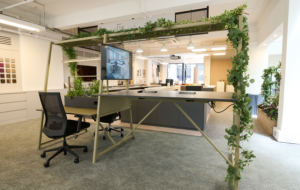

words Kieran Long
“I earn nothing. My profit last year was five pounds.” These are the words of award-winning designer Patrik Fredrikson. He is not alone.
“I try to pay myself £1,000 a month, but my mortgage is £800 and the rest pays my mobile phone bill,” says Alexander Taylor, 30. “It’s that tight, literally.”
Taylor and Fredrikson are established designers who run award-winning practices: Taylor has designed much-published pieces including the Antlers coat hook and the Fold lamp, while Fredrikson, 37, was named Young Swedish Designer of the Year in 1998, and this year won a £10,000 award from British grant-giving organisation the Arts Foundation for his highly conceptual work.
The fact that both of these designers work for almost no money is a normal state of affairs in the furniture industry. Designers at the beginning of their careers – even those with high media profiles and award-winning products for major manufacturers behind them – feel forced to accept contracts that may never pay them a penny. Manufacturers are effectively exploiting both their inexperience and their desire to get pieces into production.
Shelley Warren, director of the Arts Foundation, says that the average income of designers who apply for bursaries is just £10,000-£15,000 per year.
“I would have expected designers to be better off, but their earnings are comparable to fine artists,” says Warren. “I think it’s the responsibility of the industry [to support young designers]. But there’s a real gap – there’s not much support.”
The problem lies in the licensing deals manufacturers offer young designers, which typically pay paltry royalties, offer no up-front payment and come with no guarantee that the design will ever be manufactured. Sometimes manufacturers simply sit on the design until the license expires – which can be up to seven years.
“The licensee is a big company exploiting a small one,” says design industry lawyer Margaret Briffa. “Ninety per cent of the contracts we see are unsignable because they are just not equitable. Changes have to happen.”
A typical contract with a major furniture manufacturer will be a royalty-only arrangement paying just 2-5% of the factory price – usually around a quarter of the retail price. So a light that sells for £100 may earn the designer just 50p for each unit sold.
“It’s an abuse,” says Luke Pearson of industrial designer Pearson Lloyd. “If you’re on a royalty of 2-5 per cent of the factory cost, you’re going to have to sell a lot of furniture not to make peanuts.”
Designers routinely sign licensing agreements where no minimum production run is specified, meaning that the companies effectively get the product, and use the designer’s name, for free. “It could be a completely worthless deal for the designer,” says Briffa.
“Young designers are often asked to send sketches of ideas for free,” adds Pearson, whose company rarely signs royalty-only deals. “They don’t realise [the manufacturer] has also asked ten other designers to do the same thing.”
While there are known examples of unscrupulous deals being made, in most cases it is simply the terms of standard contracts that force designers to exist for years on subsistence wages while they try to establish their offices.
“A lot of designers won’t make much money,” says Thorsten van Elten, who runs a small furniture manufacturing company in London. He argues that the early years of a career are about building a profile that will benefit the designer in the long run. “Your name is your most important asset”, he says.
Other manufacturers defend the royalty-only system. “Like all other companies, we have royalty-only agreements,” says Caspar Vissers, who co-founded Dutch furniture manufacturer Moooi with designer Marcel Wanders. “There are some young designers who make huge money from this – like the Random Light by Bertjan Pot and the Light Shade [by Jurgen Bey]”. Vissers says that the royalties from these products alone earn their designers a reasonable annual income.
The cost and risk of developing new products justifies the royalty-only arrangement, Vissers says. “There is a risk for Moooi, so we don’t say that we will pay a minimum amount. All we need from a designer is a sketch – then we have product development teams. It’s only the idea that they give to Moooi. There are a lot of brands who expect designers to give fully developed products, but we choose products at a very early stage.”
But Pearson disagrees that manufacturers shoulder their share of risk. “If you are a sole trader, you might spend three months [working on a design] – and you’re working for nothing. I think that’s really wrong.”
London-based furniture designer Taylor developed his Fold lamp independently before the design was licensed by new British furniture brand Established & Sons. He is still waiting for his first royalty cheque. “This time last year I was thinking that the royalty from the lamps and from the E&Y chair would start to come through, and I could start to think about paying myself another £100-200 per month.”
Established & Sons also has “generally royalty-based” agreements, which vary according to the designer involved. Director Mark Noble says: “Often an intense and expensive period of development is required prior to that product reaching the stores, and that is our commitment to the product and the designer. We have a payment system in place which reflects this, is fair to both parties and inevitably lucrative for our designers.”
Taylor maintains that royalties will be a realistic revenue stream for him in the future. “I totally believe you can make a living off royalties. You just need a killer product. One decent lamp for Flos and you’re quite happy.”
Briffa’s advice is not to be afraid of negotiation. “It’s like any other piece of intellectual property – you can decide to give it away, license it, sell it. But when people negotiate they do get a better result.” And, she adds, be clear about what you are trying to get out of the agreement. “Even if you are getting a really crummy royalty rate and the deal is bad, you want something for your portfolio,” she says.
Van Elten advises caution, however. “You have to be careful who you work with,” he says. “It’s like anything in life – if you deal with the wrong people you’ll get screwed over. Designers need to learn that.”















